Ashford WwTW (2013)
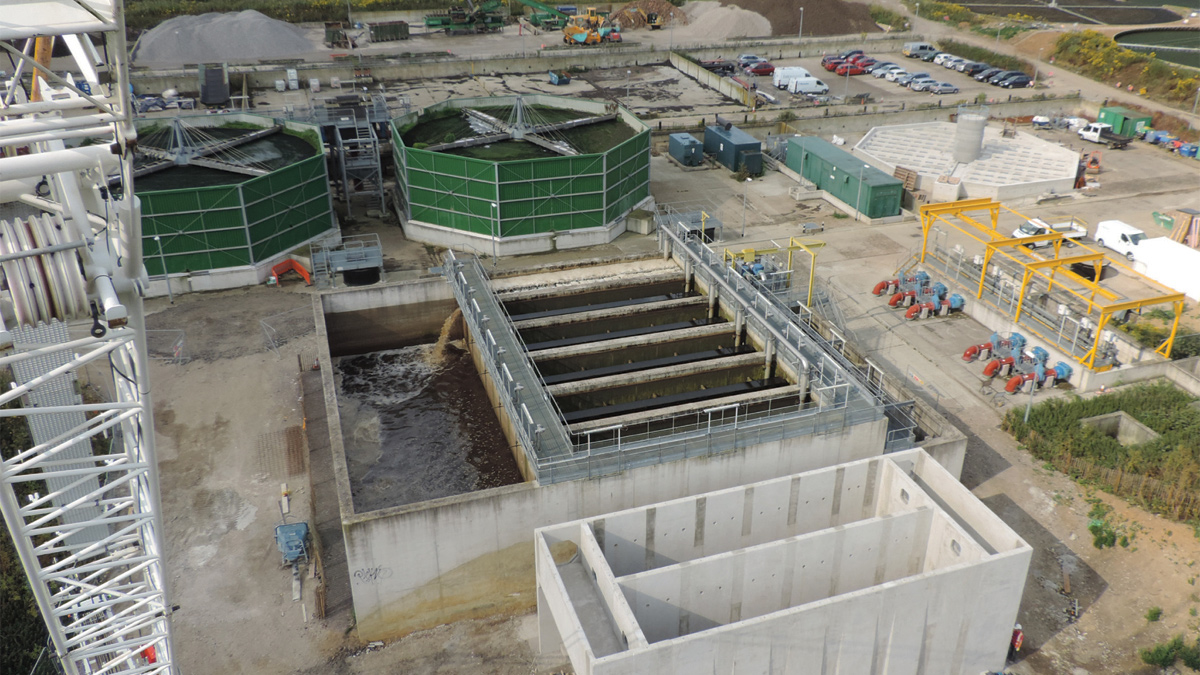
Deep bed sand filters in foreground and the construction of nitrifying trickling filters No 4 to the right with the filter refurbishment wash plant in the background and the biological filters to the far right - Courtesy of BTU
Ashford is located approximately 15 miles north-west of Folkestone in Kent. The wastewater treatment works currently serves a population equivalent (PE) of 100,000 which is forecast to increase to 130,000 by 2020. Southern Water is investing £12.6m to upgrade and modify the process units at Ashford WwTW to meet future increases in flows and loads (increase of 30% in the FFT from 537 l/s to 694 l/s) and to achieve tightening discharge environmental permit limits (National Environmental Programme (NEP) consent requirements).
Undertakings
In March 2012, Southern Water appointed BTU (a joint venture between Trant Holdings Ltd and Barhale Plc formed solely to service Southern Water on their MSF contract for AMP5) as Principal Contractor for the extension works of Ashford WwTW. BTU, along with their delivery partner, URS, undertook the design and construction of the project.
Ashford WwTW: Supply chain – key participants
- Main designer: URS
- Temporary works designers: Barhale Plc
- Inlet screens, screenings handling plant & other associated plant: Longwood Engineering
- Refurbishment of the 16 (no.) biological filters – Filter arms: Ashbrook Simon-Hartley
- Refurbishment of biological filters – Media: Days Group
- Construction of humus tanks: Carlow Precast (now FLI Precast Solutions)
- Humus tanks – Scraper bridges: AJ Fab Tech
- Construction of a nitrifying trickling filter: Sewaco
- New nitrifying trickling filter – Media: Hewitech UK Ltd
- Deep bed sand filters – Shell: Carlow Precast (now FLI Carlow)
- Deep bed sand filters – System: De Nora
- MCC/Systems integration: Max Wright
- MCC/Systems integration: MCS
- Access and stairs manufacture: Barhale Plc
- Electrical installation: FSD Ltd
- Mechanical Installation: Arnolds Environmental
- Minor civil works: NBC
- Civils installation: Barhale Plc
- Piling: Roger Bullivants
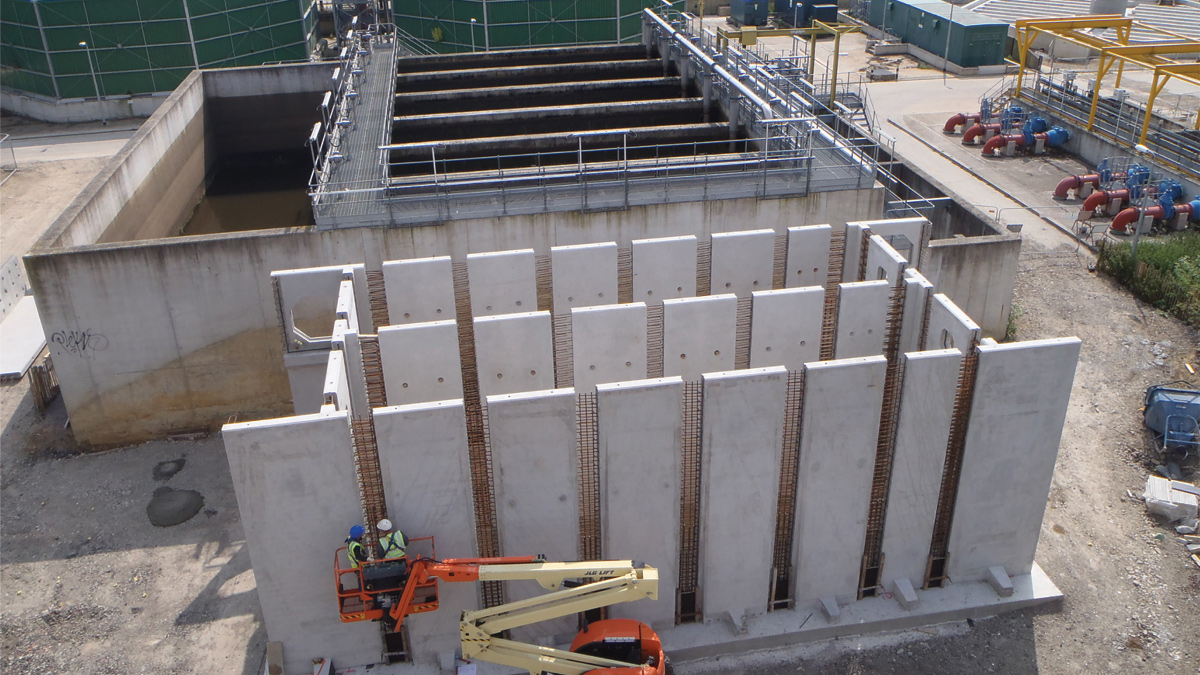
Construction of 2 (No.) additional precast deep bed sand filter cells – Courtesy of BTU
Works requirements
The following works were identified for the extension in order to meet the consent standards and forecast rise in the PE:
- Upgrading of the inlet works.
- Refurbishment of the 16 (No.) biological filters.
- Construction of 1 (No.) humus desludging pumping station and MCC kiosk for control panel for pump sets.
- Construction of 2 (No.) 27m diameter humus tanks.
- Construction of a new nitrifying trickling filter (NTF) to match the 3 (No.) NTFs already on the WwTW and an elevated walkway to link the 4 (No.) NTFs together.
- Construction of 2 (No.) deep bed sand filters (DBSF) to match the 3 (No.) on the WwTW.
- Refurbishment and upgrade of the recirculation pumping station.
- Refurbishment and upgrade of the NTF feed pumping station.
- Refurbishment and upgrade of the DBSF feed pumping station.
- Refurbishment and upgrade of wash water pump set. (This is in addition to the new washwater pump set to be provided at the inlet works).
- Associated chambers, manholes, pipelines and ducts.
Interface management
Through corporate design and construction procedures, BTU, URS and Southern Water, established a series of design workshops to ascertain the exact objectives and milestones the project would need to deliver. The challenges that all project stakeholders faced on the Ashford project was the limited as built design and assets information for the existing site.
This element was mitigated by undertaking a series of workshops which also included the interaction with the supply chain and the existing operational staff of the WwTW. By conducting these workshops the team were able to maintain an easier changeover from the HAZOP and Assets Lifting and Maintenance to Issue for Construction process as all the key project stakeholders had been involved in the design process from project design conception.
This allowed for a more accurate supply chain tendering process to be established, dramatically reducing the unknown risk element within the tenderer’s submissions and ensured that the interface and integration issues were fully understood and planned across the various packages.
As a result of the early key collaboration between the client and supply chain at the project conception, Barhale were able to demonstrate to Southern Water that utilising innovative off-site precast concrete design and construction methods for the humus tanks and deep bed sand filters, would enhance both programme benefits and provide factory quality finishes.
This significantly reduced health and safety risks to employees, removing the need for laborious activities such as scaffolding, formwork, concrete pouring and finishing.
By adopting a production-based assembly approach the overall construction programme was reduced by 6 weeks, with associated cost and risk reduction benefits.
Weekly stakeholder progress meetings for the project has ensured the direct interface process has carried over to the construction phase and consequent commissioning phase, all in all confirming that all main objectives set out in the initial pre-construction stages have been met and incorporated into the project.
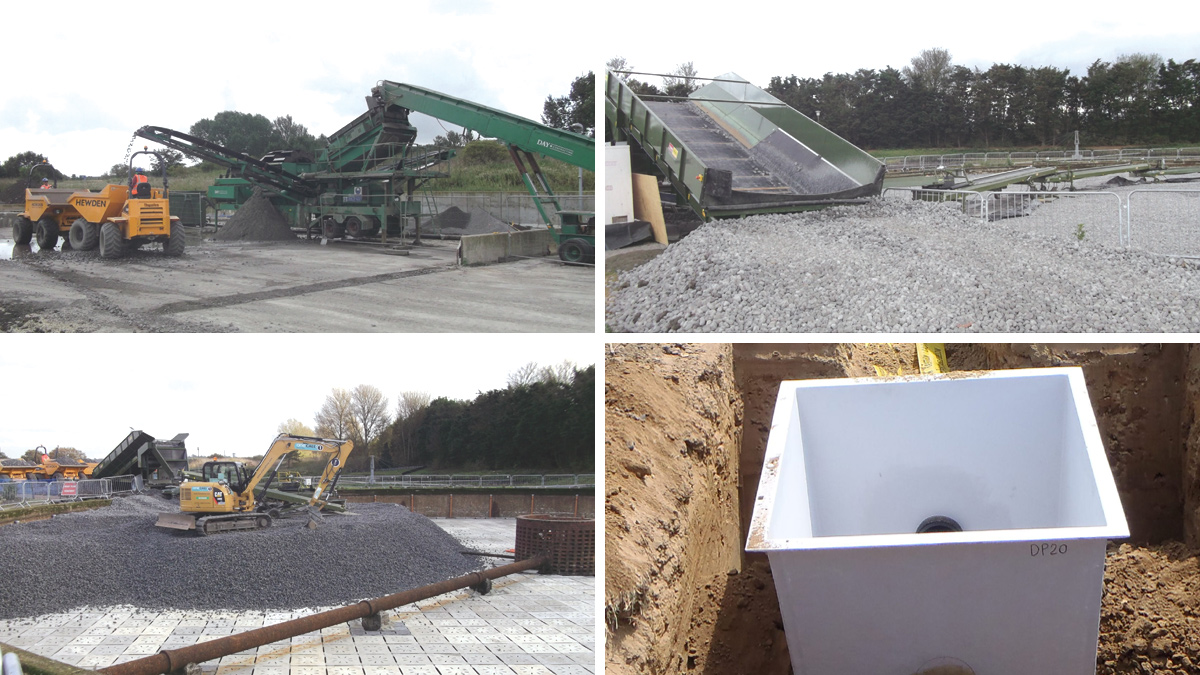
(top left) Wash plant for processing new and existing filter (top right) filter refurbishment conveyor system for placement of media (bottom left) placement of new filter media in newly tiled 42m dia biological filter using a conveyer system which greatly reduced the chances of damage through compaction by dump trucks and (bottom right) construction of GRP draw pit and ducting system – Courtesy of BTU
Water efficiency
Southern Water has faced water shortage issues over recent years. Drought conditions have increased water company support of water efficiency implementations and by promoting beneficial use of final effluent. BTU are supporting this initiative. For cleaning the filter media BTU are undertaking the following:
- Filter media is excavated from the filter bed and transported to the wash down area.
- Here it is loaded into the feed hopper of the wash plant.
- Final effluent is pumped into the wash plant from the effluent channel at a rate of 25-35 litres per second.
- The material is then washed over two screen decks which sieve the media into two size groups, removing fines.
- Clean media is then returned to the filter beds and the settled fines are removed and disposed of.
- The excess screened water is then returned to the head of the WwTW.
Construction challenges
One of the primary drivers of the project was to ensure that the effluent quality of the live works was not compromised whilst new construction and modifications to the existing plant are ongoing. The relationship between the construction and operations teams was therefore critical to ensure that dialogue was maintained and there was continuous awareness of each other’s activities.
There have been many activities that have required several reviews and workshops with the client to ensure that the current processes on site are maintained. Some of the complex activities for the project are as follows:
- Installation of limpet plates to live chambers to allow the installation of new pipelines into the structures (works return pumping station and NTF DBSF pumping station).
- Installation of temporary dams to existing inlet channels to allow connections between new and existing structures (deep bed sand filters).
- Construction of 2 (No.) humus tanks within existing irrigation beds below existing groundwater level. A dewatering ejector system has been installed to allow construction of these structures, associated chambers and pipelines within a dry environment.
- Construction of 2 (No.) new flow split chambers (influent & effluent) over existing large diameter feed pipelines. Once constructed there will be a series of shut downs, diversions, isolations and possible over pumping to allow the existing lines to be broken out and made good within the new structures.
All of the above works are tightly constrained due to the current consent levels (summer) and the minimal windows of opportunity in relation to diverting to the storm tanks and shutting down certain parts of the treatment process which is currently a maximum of 3 hours.
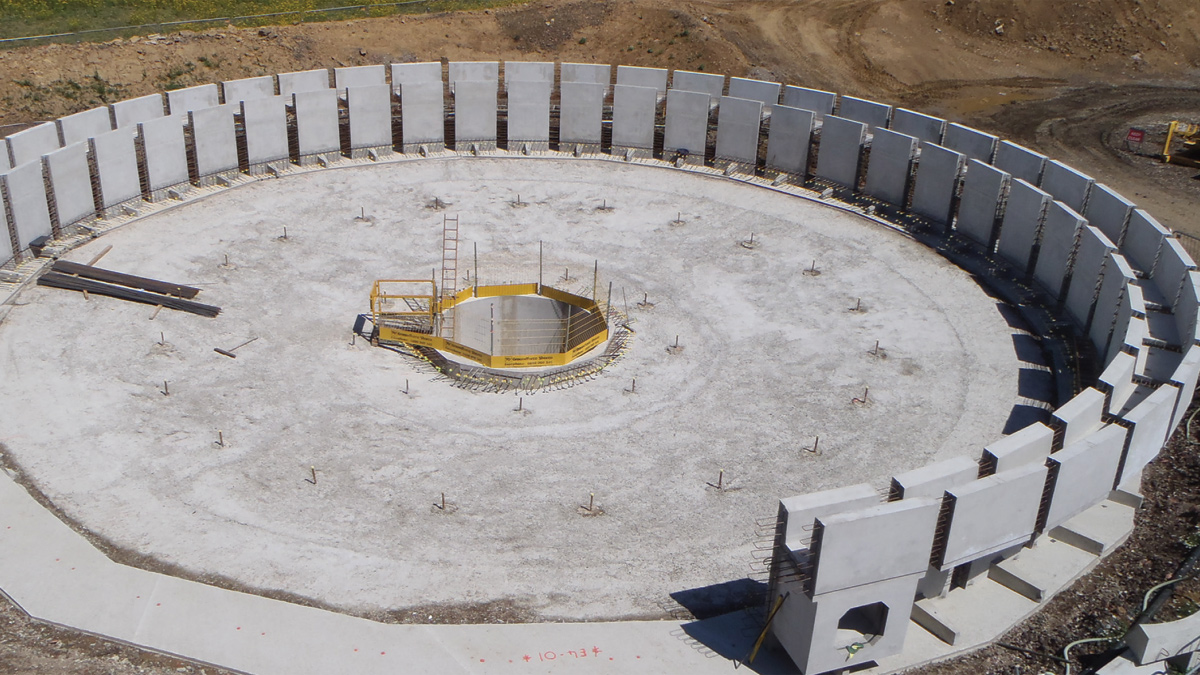
Construction of precast humus tank No 10 – Courtesy of BTU
Value engineering & innovation
There have been several opportunities within the Ashford project to implement innovative design concepts which have decreased programme duration, resource, carbon footprint and have also reduced some of the on-site risks for these types of works.
To follow are some of the areas of work where benefits have been realised through value engineering and innovation:
Humus tanks & deep bed sand filters (DBSF)
- Design: Tanks designed in precast instead of traditional in-situ method. The tanks were also relocated to the existing irrigation beds allowing minimal temporary works (central hoppers only) instead of huge excavations and muck shifts which would have been required in the original location.
- Programme: Due to offsite fabrication of the humus and deep bed sand filter units, 6 weeks have been saved on the installation in comparison to using in situ concrete structures.
- Health & Safety: There has been minimal requirement of man hours working at height. Reduced risks due to reduced programme and resources in all other areas of the construction of these structures.
- Customer, Community and the Environment: Significantly reduced impact due to the major reduction in muck away off site, and concrete, reinforcement and associated construction plant and materials deliveries to site.
Draw pits
- Design: The design was revised and a WWAM4118 submitted to the Southern Water to allow the use of GRP chambers in certain untracked locations.
- Programme: The current standard detail of a brick chamber would take 3 days to construct against the half-day duration for the full installation of the GRP chamber. The overall benefit to programme for the project has been a gain of 64 days.
- Health & Safety: Changed covers from D400 to B125 in untrafficked areas which are lighter and easier to handle whilst installing. This shortened the duration of installation resulting in less exposure to generic risks such as excavations and working at height.
- Environment: Zero concrete and brickwork, minimal plant, a shortened duration for installation and a reduction of deliveries of materials to the site, reduced impact on the local residents and businesses, and benefitted from a resultant reduction in overall embedded carbon.
Biological filter refurbishment
During the project 35,000 tonnes of old filter media has been excavated that will not be reused. To prevent the need for the importation of new fill the excavated material has been incorporated into several aspects of the project such as temporary access roads on the site, crane platforms, fill to redundant chambers/structures and piling platforms.
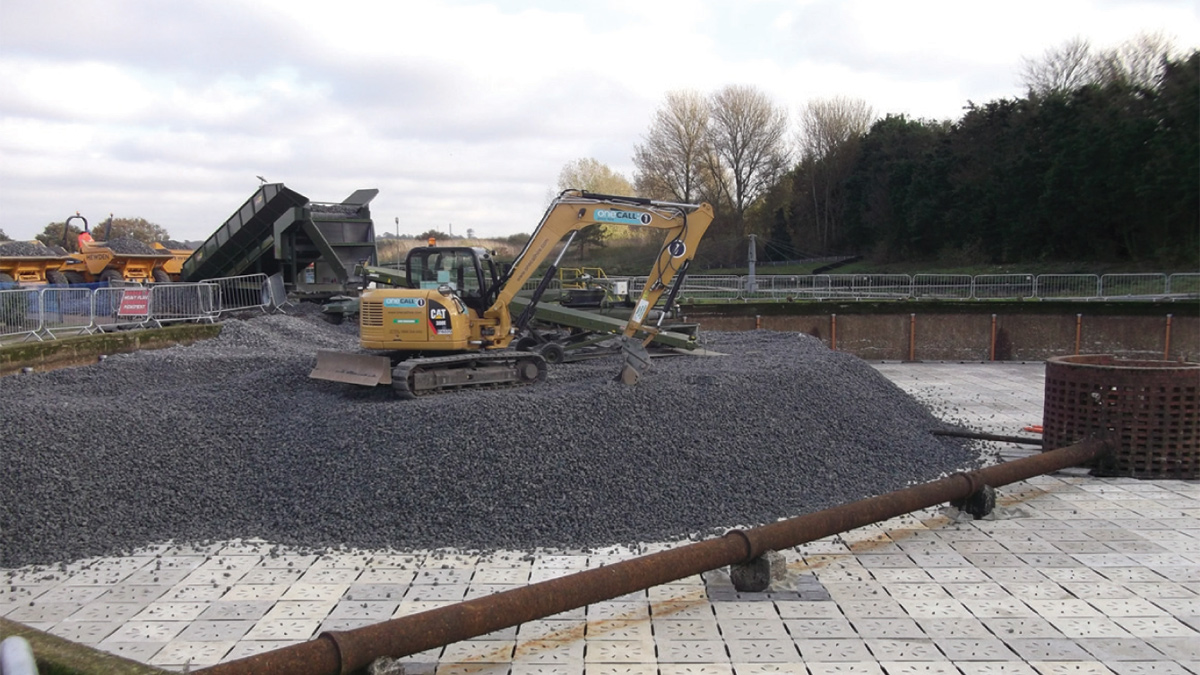
Placement of new filter media in newly tiled 42m dia biological filter using a conveyer system which greatly reduced the chances of damage through compaction by dump trucks – Courtesy of BTU
Surplus arisings
To date approximately 1,500m3 of arisings are stored on the site. With careful planning and profiling around the new structures, the intention is to use all of the material for backfill, removing the requirement for over 90 HGV movements when taking bulking into consideration.
Meeting the need
In order to fulfill the key drivers for the project, Southern Water and BTU are working together to ensure that:
- The Ashford project is successfully completed by 31 March 2014 meaning that the WwTW is ready to treat the additional capacity prior to the summer consent levels, which commence 1st April 2014.
- A quality product is delivered safely, efficiently and responsibly, within budget and on programme.
- A close working relationship between Southern Water and BTU will ensure that the existing site processes are maintained whilst delivering the new works with minimal impact on the live wastewater treatment works.
Conclusion
Since the conception stage, this project has required detailed planning in all areas, from outline design through to the commissioning of the additional infrastructure. At the time of writing (August 2013) BTU are well advanced with the upgrade and on target to complete by March 2014.
Looking ahead, there will be many difficult activities to complete and a lot of interaction between civil and mechanical and electrical elements of the work including integration between the new and old signals and control systems. Further detailed planning and close collaboration with the client and supply chain will ensure smooth delivery to enable the final commissioning and successful integration of the new asset into operation, for the long term benefit of the customers of Southern Water.





